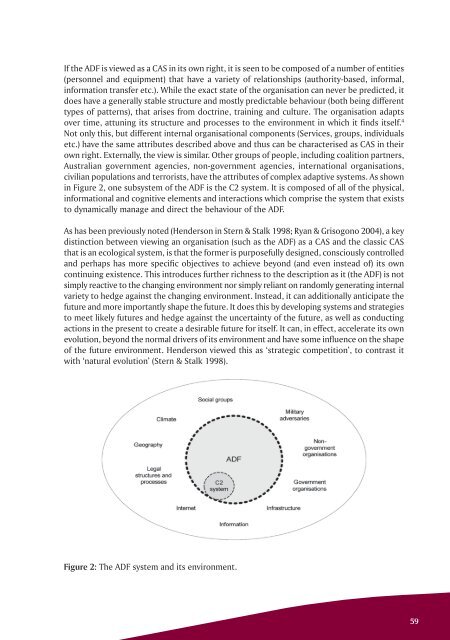ISSUE 176 : Jul/Aug - 2008 - Australian Defence Force Journal
ISSUE 176 : Jul/Aug - 2008 - Australian Defence Force Journal
ISSUE 176 : Jul/Aug - 2008 - Australian Defence Force Journal
You also want an ePaper? Increase the reach of your titles
YUMPU automatically turns print PDFs into web optimized ePapers that Google loves.
If the ADF is viewed as a CAS in its own right, it is seen to be composed of a number of entities<br />
(personnel and equipment) that have a variety of relationships (authority-based, informal,<br />
information transfer etc.). While the exact state of the organisation can never be predicted, it<br />
does have a generally stable structure and mostly predictable behaviour (both being different<br />
types of patterns), that arises from doctrine, training and culture. The organisation adapts<br />
over time, attuning its structure and processes to the environment in which it finds itself. 4<br />
Not only this, but different internal organisational components (Services, groups, individuals<br />
etc.) have the same attributes described above and thus can be characterised as CAS in their<br />
own right. Externally, the view is similar. Other groups of people, including coalition partners,<br />
<strong>Australian</strong> government agencies, non-government agencies, international organisations,<br />
civilian populations and terrorists, have the attributes of complex adaptive systems. As shown<br />
in Figure 2, one subsystem of the ADF is the C2 system. It is composed of all of the physical,<br />
informational and cognitive elements and interactions which comprise the system that exists<br />
to dynamically manage and direct the behaviour of the ADF.<br />
As has been previously noted (Henderson in Stern & Stalk 1998; Ryan & Grisogono 2004), a key<br />
distinction between viewing an organisation (such as the ADF) as a CAS and the classic CAS<br />
that is an ecological system, is that the former is purposefully designed, consciously controlled<br />
and perhaps has more specific objectives to achieve beyond (and even instead of) its own<br />
continuing existence. This introduces further richness to the description as it (the ADF) is not<br />
simply reactive to the changing environment nor simply reliant on randomly generating internal<br />
variety to hedge against the changing environment. Instead, it can additionally anticipate the<br />
future and more importantly shape the future. It does this by developing systems and strategies<br />
to meet likely futures and hedge against the uncertainty of the future, as well as conducting<br />
actions in the present to create a desirable future for itself. It can, in effect, accelerate its own<br />
evolution, beyond the normal drivers of its environment and have some influence on the shape<br />
of the future environment. Henderson viewed this as ‘strategic competition’, to contrast it<br />
with ‘natural evolution’ (Stern & Stalk 1998).<br />
Figure 2: The ADF system and its environment.<br />
59

















